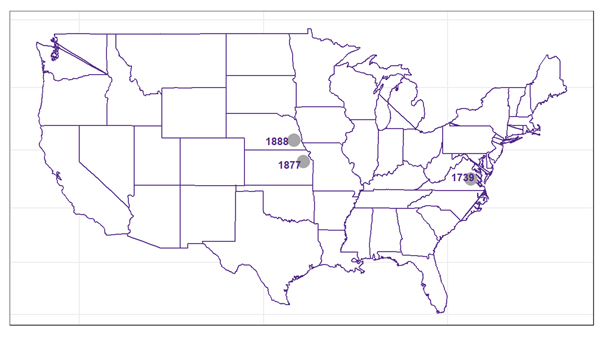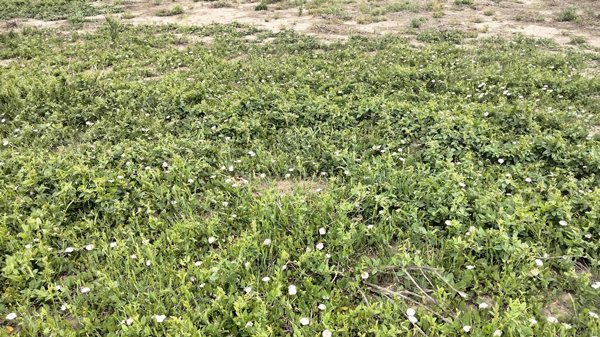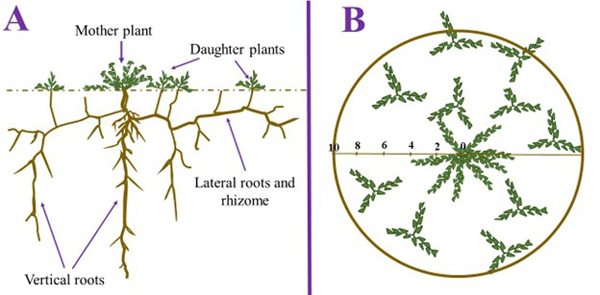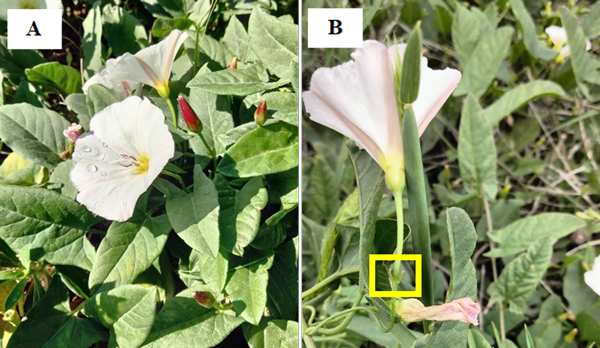Field bindweed (Convolvulus arvensis L), a perennial vine in the morningglory family, infests millions of acres in the Great Plains. This weed significantly reduces crop yield and quality, reduces land value, interferes with harvest by entangling crop plants, and increases production costs associated with control practices. Earlier research in Hays, KS, over the span of 12 years, indicated that dense stands of field bindweed induced 20% to 50% cereal crop yield loss and 50% to 80% row crop yield reduction.
In North America, field bindweed was first reported in Virginia in 1739. It was possibly brought to Kansas in infested wheat seed from the Ukrainian region of Russia between 1870 and 1875. In 1877 and 1888, it was reported near Topeka (Kansas) and Nebraska, respectively (Figure 1).

Figure 1. Field bindweed was first reported in Virginia in 1739, near Topeka (Kansas) in 1877, and in Nebraska in 1888.
Ecology of field bindweed
Growth and development. Seeds near the soil surface will germinate throughout the growing season following rainfall. Seedling emergence primarily occurs in the spring, usually in early to mid-April in Kansas, and continues growing until November or until temperatures drop to 20°F or lower; at these temperatures, its growth may be retarded, but the vines do not die. Seedlings quickly develop a deep taproot and numerous lateral roots about six weeks after emergence. Once lateral roots grow, the plant has a perennial growth habit (Figure 2). Growth ceases during severe drought, but new top growth appears after adequate rainfall. May 15 to June 15 is the heaviest bloom period in west-central Kansas, with the seed usually maturing from June 15 to July 15. However, field bindweed can continue to bloom under favorable conditions and produce seed during July and August.

Figure 2. Field bindweed infestation. Photo by Jeremie Kouame, K-State Research and Extension.
Roots and food reserves. Field bindweed stores a large quantity of carbohydrates deep into its root system, which provides energy for below- and above-ground growth. Roots can have a lateral spread of approximately 10 feet in one season and may penetrate 18 to 20 feet (Figure 3). In two or three growing seasons, roots may extend to a diameter of 17 to 18 feet. In areas with average annual precipitations of 30 inches or more, field bindweed roots have been found 30 feet below the surface. However, on upland soils near Hays, where annual precipitation averages 23 inches, few roots were found below 6 feet. Also, more than 60% of the total weight of roots is reported to be in the top two feet of soil. Buds formed along lateral roots can develop into shoots, which become new plants when they surface.

Figure 3. Field bindweed (A) mother plant with vertical and lateral roots and daughter plants (B) lateral spread with the mother plant in the center and daughter plants up to 10 feet away in all directions. Redrawn from Hillary Broad.
Dispersal mode. Field bindweed spreads by root segments and seeds, both of which can be spread by road maintenance equipment. Root segments with buds are dispersed by tillage implements and are capable of starting new plants when the soil has adequate moisture.
Spreading by seed occurs when:
- Vines, wrapped around tools and those that pass through harvesting equipment, drop field bindweed seeds.
- Seeds are collected with harvested grain and often planted with crop seed.
- Seeds in grain or hay fed to livestock pass through animals undigested and spread with manure.
- Seed is transported by drainage water, birds, animals, machinery, and vehicles.
Identification of field bindweed

Figure 4. (A) A flowering field bindweed plant. (B) A field bindweed flower with two small bracts is present about 1 inch below the flower (yellow rectangle). Photo by Jeremie Kouame, K-State Research and Extension.
- Two cotyledons, present on plants emerging from seedlings and absent from those emerging from perennial rhizomes, are smooth and square to kidney-shaped.
- Leaves are alternate, smooth to hairy, and triangular to arrow-shaped with entire margins and rounded apical tips.
- Stems are twisting, prostrate unless climbing, smooth to hairy.
- The corolla of flowers is funnel-shaped (Figure 4A-B), 1 to 2 inches long, and varies from white to pink. Two small bracts are present about 1 inch below the flowers (Figure 4B).
- Each flower produces a nearly round seedpod containing 1 to 4 dark brown or black 3-sided seeds. Seeds are viable 10 to 15 days after pollination when seed moisture is down to 80%.
Management
Because field bindweed has long seed viability and tremendous food reserves stored in roots, a long-term management program is required for its successful control. A single application of a herbicide will not eradicate established stands.
A companion article in next week’s eUpdate will discuss the best options for effectively managing bindweed.
Jeremie Kouame, Weed Scientist, Agricultural Research Center – Hays
jkouame@ksu.edu
Randall Currie, Weed Scientist, Southwest Research Extension Center - Garden City
rscurrie@ksu.edu
Sarah Lancaster, Extension Weed Management Specialist
slancaster@ksu.edu